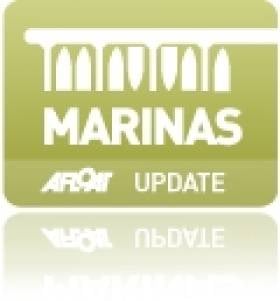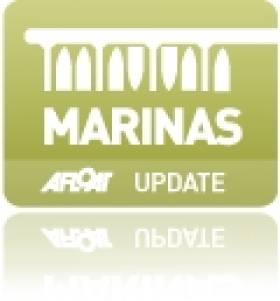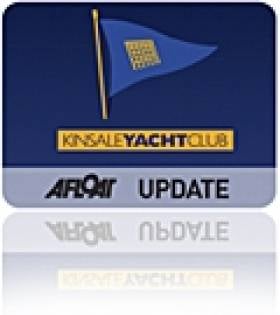Displaying items by tag: Marina
UK Boaters 'Surprised To Learn' of Irish Marina Facilities
There's been a big shout out for the Irish Marine Federation (IMF) stand at this week's London Boat Show from UK boaters who have been 'surprised to learn' of the range of sailing club and marina facilities available around the Irish coastline. But there have also been expressions of thanks from Irish visitors to the International Show at Excel who are delighted to see Ireland showcased as a maritime destination.
According to stand executive Ciara Dowling, the biggest surprise among some UK boaters visiting the stand (F046) has been the map of Ireland showing over 60 marina locations. Many visitors, she says, simply had not known of the existence of many Irish marina, jetty and pontoon locations, a situation the Irish Marina Federation are keen to rectify.
UK boater feed back from the show so far indicates the close proximity of Wales to Dublin and Ireland's attractive berthing rates compared with the current high value of Sterling against the Euro could be a factor to entice UK boaters to cruise Ireland and even moor boats here in the longer term.
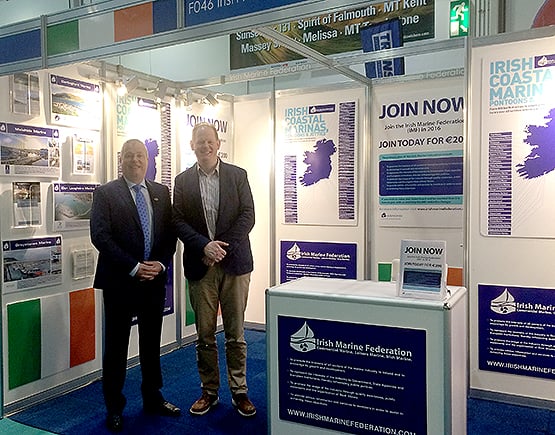
Gerry Salmon of MGM Boats and Paal Janson of Dun Laoghaire on the first ever IMF stand at this week's London Boat Show in Excel.
UK Marina Network Spends £250,000 on New WiFi Service
MDL Marinas, one of Europe’s largest leading marina operators has invested £250,000 in a new, super fast WiFi service across its network of UK marinas.
The new hardware will offer super quick internet access across all of MDL Marinas’ 19 UK marina and boatyard sites. It will enable berth holders and visitors to quickly and easily connect, stream video, Skype and handle large file downloads, and all from the comfort and convenience of their own boats.
The complimentary service is offered as part of MDL’s Freedom Berthing membership and will be accessible for all WiFi enabled mobile devices, offering a high-speed, low latency connection.
Commenting on the new offering, Adrien Burnand, Head of Marketing at MDL Marinas said: “We know from talking to our berth holders and visitors how important it is for them to have access to super fast WiFi. Whether for business or pleasure, in this day and age most of us demand and expect excellent internet access wherever we may be. We are delighted to introduce this as part of the exceptional MDL service we provide across our marinas.”
Alan Chorlton, a berth holder at MDL’s Torquay Marina added: “I am delighted that MDL Marinas has upgraded its WiFi service. When I am berthed in the marina, it’s important for me to be able to access the internet to pick up emails, connect with friends and family via Skype, as well as view and download large files. The new WiFi is exceptionally fast; it’s brilliant.”
Ireland's newest harbour and marina facility at Greystones in County Wicklow got a further boost this month with the signing of the lease of the new clubhouse for Greystones Sailing Club just before Christmas.
The lease signed is from Wicklow County Council (WCC) to Greystones Sailing Club, the buildings having been built by Sispar as part of the PPP contract with WCC.
The building has been built to shell and core stage and the Club receives a cheque to fit it out which will take a few months.
The club is not the only construction work in Greystones at the moment, Sispar are building 358 homes next to the harbour, the first of which will be completed this May.
The leases for the new clubhouses of the Angling, Rowing, Diving Clubs and Sea Scouts are expected to be signed in January.
The previous premises of the Sailing and Angling Clubs have been Compulsory Purchased as part of the Harbour Redevelopment Plan and the new ones have double the previous boat parking and clubhouse space.
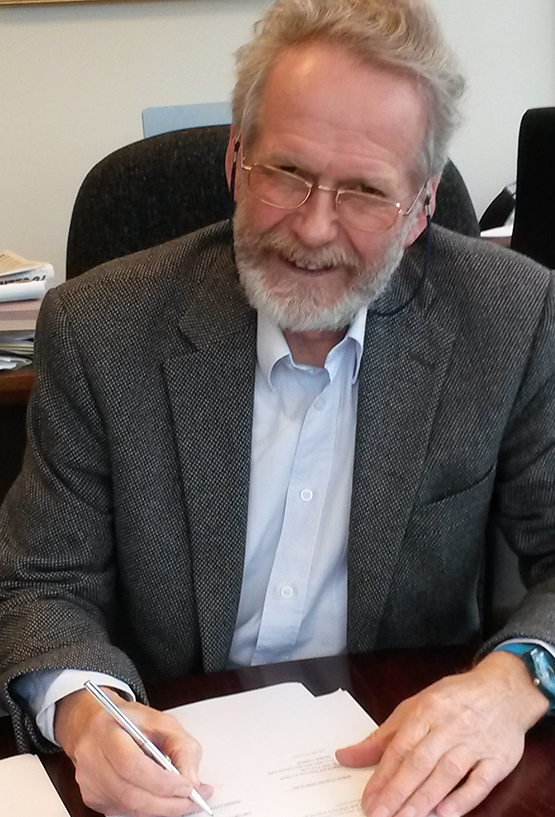
Cllr Derek Mitchell signs the new lease on behalf of Wicklow County Council
The Sea Scouts, Rowing, & Diving Clubs had no space previously and are getting smaller premise. The clubhouses are close to the sea wall and have been built very strongly as can be seen by the many reinforcing bars in the construction picture. The cost of these Community Clubs is around €4m.
‘These facilities, together with the marina and 2 public slipways, are all part of the Harbour Plan agreed by the Council in 2003, and will produce great marine leisure facilities for Greystones when they are up and running in Summer 2016’, said Cllr Derek Mitchell.
The large public square overlooking the harbour, which will be a central feature for the town, is also progressing well and will be mostly complete by the Summer.
Edinburgh Marina Development Finally Gets the Green Light
City of Edinburgh Council planning committee have granted planning consent to the revised masterplan for Edinburgh Marina. The 300 berth marina, residential, retail and spa hotel developmentwill be the focal point of Granton Harbour’s regeneration, just 2.5 miles from Edinburgh City Centre.
Edinburgh Marina is believed to be the first new Marina next to a capital city in Europe for several decades, providing a major boost to inward investment in Edinburgh of over £300m.
The Edinburgh Marina development will deliver new homes for over 4,000 residents as well as local employment opportunities for up to 800 people, whilst the new masterplan provides for improved marine services, including a community boatyard and improved facilities for the Royal Forth and Forth Corinthian yacht clubs.
The revised scheme also makes provision for the proposed new transport facilities in the area, including the extension of the tram service.
A spokesman for the developers, Granton Central Developments Limited, said today, “We are thrilled that consent has now been granted for the revised masterplan, due in part to the fantastic support of the local community who we would like to thank for their ongoing support. This is a wonderful Christmas present for the people of Granton, who have been forced to live for far too long with Granton Harbour in its current state. We’re very excited to start working towards bringing Granton Harbour to life.”
Edinburgh Marina: Fact Box
Conference & Spa Hotel: 123 beds
Residential: 2,094 units
Retail: 8930 square metres Leisure: 4220 square metres
Commercial: 5000 square metres
Marina: 300 berths
Distance from Edinburgh City Centre: 2.5 miles
Developer: Granton Central Developments Limited
Architect: Wilson Gunn Architects, Glasgow
Weather Kind to Cork Sculling Ladder
#Rowing: The Cork Sculling Ladder had a set of races on Sunday, December 20th at the Marina. In springlike conditions of showers and sunshine, water conditions were suprisingly good. Luke Guerin, who was late for his race with Conor Twohig, eventually came out on top. Twohig accepted a race, but suffered an injury.
Cork Sculling Ladder Results, December 20th
Race 1. (FC)(55) Cormac Corkery - Cork Boat Club bt (22) Peter Jackson - Lee Rowing Club. 5 Lengths.
Race 2. (14) Barry Connolly - Cork Boat Club bt (13) David Breen Lee Rowing Club. 6 Lengths.
Race 3. (7) Darragh Larkin - Lee Rowing Club bt (10) Barry O’Flynn - Cork Boat Club. 6 Lengths.
Race 4. (52) Conor Twohig - Cork Boat Club Row over (51) Luke Guerin - Presentation College Rowing Club, failed to turn up at start on time.
Race 5. (52) Luke Guerin - Presentation College Rowing Club bt (51) Conor Twohig - Cork Boat Club, DNF (Did not finish). Injured his back.
Race 6. (24) Eoin Larkin - Lee Rowing Club bt (27) Sam O’Neill - Shandon Boat Club, DNF, capsized at 900 metres.
Race 7. (49) Alex Byrne - Shandon Boat Club bt (43) bt Morgan O’Hara - Lee Rowing Club. 5 Lengths.
Race 8. (32) Liam O’Connell - Cork Boat Club bt (31) Conor McCarthy - Cork Boat Club. 6 Lengths.
Race between (33) Eoin Gaffney - Shandon Boat Club and (29) Shane Crean - Lee Rowing Club. Cancelled.
Starter : Finbarr Desmond. Umpires : Kieran Hughes and Pat Hickey.
Rearranged challenges for Sunday 27.12.2015.
(84) Kieran White - Cork Boat Club v (78) Cormac O’Connell - Presentation College Rowing Club. Time TBC.
(FC)(124) Eoin Power - Cork Boat Club v (80) Jack Aherne - Cork Boat Club. Time TBC.
Challenges. Dates and Times TBA.
(17) Feargal O’Sullivan - Cork Boat Club v (15) David Higgins - Presentation College Rowing Club.
(33) Eoin Gaffney - Shandon Boat Club v (29) Shane Crean - Lee Rowing Club.
(45) Emmett Hickey - Shandon Boat Club v (42) David Collins - Cork Boat Club.
(27) Sam O’Neill - Shandon Boat Club v (26) Neil McCarthy - Cork Boat Club
Note : Racing depends on weather conditions.
Demand for Larger Berths Grow As Marina Visitors Increase
The AGM of the Irish Marina Operators Association (IMOA) took place this month at the end of another successful season. The news from around the coast is that visitor numbers are excellent with Irish marinas attracting large numbers of boats from Britain, France and Norway in particular. Superyachts continue to see Ireland as a new and exciting destination as well as smaller cruising boats from all over the world. Some marinas are filling up again with demand being seen for larger berths in particular. Marina operators are also investing significant sums to upgrade and improve the existing facilities.
On the marketing front, the recent Southampton Boat Show was a success for a number of members who exhibited there. There is an appetite to market Ireland as a marine leisure destination and it is hoped that further marketing in the UK can be carried out.
The topic of dredging was discussed at length and the members aired their frustration at the drawn-out process to receive permission to carry out maintenance works. Similarly it was disappointing to hear that there is still no movement on the Maritime Area and Foreshore (Amendment) Bill 2013. The lack of progress on this front is potentially damaging for the industry as a whole.
Finally, it was agreed by all members that there is a change in the outlook of customers/boat owners and a more positive attitude is evident right around the coast.
Byrne Out on His Own at Cork Sculling Ladder Time Trial
#Rowing: Ronan Byrne of Shandon Boat Club won the Cork Sculling Ladder time trial in an excellent time of six minutes 20.2 seconds today. Byrne had been the joint winner last year. Margaret Cremin of Lee Rowing Club was the fastest woman, in a time of 7:10.5.
One hundred and sixty six scullers competed in 44th time trial, sponsored by Hanley Calibration Ltd, over the 1800 metre course at the Marina. Some scullers competed twice: most sculled on the early incoming tide until nearly 11 am, helped by an easterly wind. Conditions early on were good, but once the tide changed they deteriorated and the ladder finished at 12 noon.
Cremin, winner of the novice championship of Ireland this year, easily won from her clubmates, Willow Littlewood and Eimear Cummins.
The 2015-2016 Cork Sculling Ladder continues with challenge races until the 28th March. Scullers can join at any stage.
Cork Sculling Ladder, time trial (Selected Results)
Men
1. Ronan Byrne (Shandon Boat Club) 6 mins 20.2 seconds, 2. Colm Hennessey (Shandon Boat Club) 6:23.1, 3. Jack Casey (UCC Rowing Club) 6:23.6, 4. Stephen O’Sullivan (Shandon Boat Club) 6:24.9, 5. Sean Lonergan (Shandon Boat Club) 2:27.5, 6. Darragh Larkin (Lee Rowing Club) 6:27.6.
Women
53. Margaret Cremin (Lee Rowing Club) 7:10.5, 67. Willow Littlewood (Lee Rowing Club) 7:26.5, 73. Eimear Cummins (Lee Rowing Club) 7:34.4, 74. Jennifer Crowley (Shandon Boat Club) 7:35.8.
#kilrushmarina – Kilrush Marina recently celebrated 12 months under new ownership having carried out an extensive upgrade and modernisation to the facilities costing in excess of €1m.
As Afloat.ie reported back in March, Kilrush Marina was taken over in July 2014 from the semi state company Shannon Development who oversaw the construction of the 120 berth marina in 1991. Included in the work was the overhaul of the lock gates which included shotblasting and painting, structural repairs, new seals and an automated system to make them 24 hr accessible.
The pontoon electrics were replaced, an automated 24hr fuel system was installed,wi fi accessible on all pontoons. Security was upgraded with comprehensive CCTV and automated gates on both pontoons and boatyard. The Marina Centre building was refurbished, and new showers installed in the changing rooms, the Marina entrance and car parks were landscaped and tarmacked.
In the boatyard, the drainage was redone,shed roofs repaired and a 16 ton hydraulic boat trailer purchased to compliment the existing 45t–travel hoist.
The final job was dredging the access channel, which because its in a Special Area of Conservation took a lot of time and effort to get permission.
However its finally done and provision is now in place for annual maintenance dredging.
Kilrush Marina is the only full service marina on the west coast offering a full range of boatyard and berthing options and is easily accessible from both Shannon Airport 45 minutes away and the motorway network 30 minutes away.
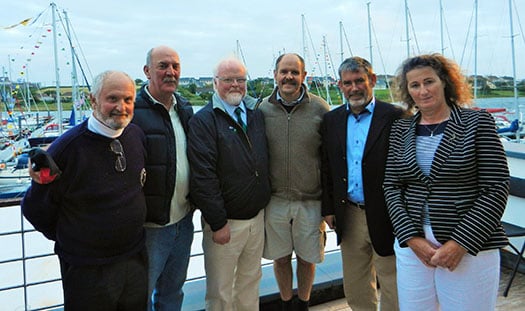
(L to R) Adrian O'Connell, Commodore Royal Western YCI , James Mc Cormack Commodore, Foynes YC, Pierce Purcell, Irish Sailing Association, Richard Hurley, Commmodore Tralee Bay SC, Louis Keating Managing Director L&M Keating, Kim Roberts, Kilrush Marina Manager.
More Superyachts Arrive at Kinsale Yacht Club Marina
#superyacht – No sooner has the ICRA Championships and Sovereign's Cup fleet departed Kinsale Yacht Club marina than Superyachts Ghost (35M), a return visitor and new arrival to Irish waters Clan VIII (45.3m) have taken a berth on the yacht club marina.
As it happens KYC was also hosting a party for The Yacht Harbour Association who are currently reviewing the five anchor marinas in Ireland. Strategically located in West Cork, the port of Kinsale offers deep water berths, a yacht club and nearby waterside town facilities.
In a presentation to the group Bobby Nash (KYC's Rear Commodore) explained the strategic importance of the marina for cruising yachts to the Irish coastline.
Kinsale Yacht Club has won a blue flag for its coastal marina for the first time in today's An Taisce announcement of the International Blue Flag Awards for 2015.
A total of 144 awards were presented by the Minister for the Environment, Community and Local Government, Mr. Alan Kelly, T.D, at an awards ceremony held on Ballinskelligs Beach in Kerry. Ireland's diverse coastline with long sandy beaches, bustling promenades and rocky shores have something for everyone.
Kinsale Yacht Club marina is located in a natural, virtually land-locked harbour on the estuary of the Bandon River, approximately 12 miles south west of Cork harbour entrance. It is home to a thriving fishing fleet as well as frequented by commercial shipping, it boats two fully serviced marinas, with the Kinsale Yacht Club & Marina being the closest to the town.Visitors to this marina automatically become temporary members of the club and are therefore entitled to make full use of the facilities.
Speaking at the awards ceremony Minister Kelly said, "Blue Flags represent excellence. They are a clear signal of quality and are something to be cherished. I am delighted to announce that today we will be awarding a total of 86 Blue Flags; 81 for beaches and five for marinas. A blue flag flying at a particular location means that it has achieved excellent water quality to standards set by European and national Regulations, and a very high grade across a wide range of other criteria"
He added that, "This is testament to the sterling efforts of local authorities, An Taisce and of local communities in ensuring that their beaches meet the standards of excellence required for a Blue Flag or Green Coast Award',
81 beaches and 5 marinas were awarded the prestigious Blue Flag award representing an increase in 6 Blue Flag awards since 2014.
Ms Annabel FitzGerald, Coastal Programmes Manager said that, "The Blue Flag is an award of excellence, the beaches and marinas that have achieved this accolade today have complied with strict criteria relating to water quality, safety, facilities for visitors, beach management, environmental education and the provision of information."
In Cork, Redbarn and Garretstown have regained the Blue Flag status and in Wexford, Ballinesker is being awarded the Blue Flag for the first time. 5 beaches that failed to comply with the requirements of Blue Flag in 2014 because of storm damage have regained their Blue Flag status, they are Bertra and Mulranny in Mayo, Rossbeigh in Kerry and Miltown Malbay and Spanish Point in Clare.
Brittas Bay North in Wicklow, Enniscrone in Sligo and Skerries in Fingal have lost their Blue Flags due to failure to comply with water quality requirements for the Blue Flag.
58 beaches in Ireland were awarded the Green Coast Award representing an increase in 4 awards since 2014. Bishopsquarter and Seafield in Clare and Inchydoney East in Cork are being awarded for the Green Coast Award for the first time. In Wexford, Ballyhealy, Ballymoney, Booley Bay, Grange and St Helens Bay have also achieved the accolade.
Having not met the excellent standard required, Skerries in Fingal, Rathmullan in Donegal, Enniscrone in Sligo and Ballycastle in Mayo did not regain the Green Coast Award for 2015.
"The Green Coast Award recognises beaches for their clean environment, excellent water quality and natural beauty. These beaches may not have the necessary built infrastructure required to meet the criteria set for Blue Flag status however they are exceptional places to visit and enjoy our rich coastal heritage and diversity."
An important aspect of the Green Coast Awards is the involvement of Clean Coasts groups of which there are now 440 comprised of thousands of volunteers throughout the island. Ms FitzGerald, paid tribute to these groups stating that, "Clean Coasts groups contribute significantly to the protection of Irelands coast, in 2014 over 800 beach cleans took place and these groups removed over 500,000 items of marine litter from the marine environment."
"Local Authorities, Marina Operators and local communities should be commended for their efforts in achieving Blue Flag and Green Coast award status today" Ms FitzGerald concluded.
SUMMARY OF AWARDS
o 144 awards presented today, an increase of 10 on last year's number.
o 86 Blue Flags are being awarded today in the Republic of Ireland, 81 to beaches and 5 to marinas.
o This is an increase of 6 Blue Flags since 2014, representing an increase of 5 Blue Flag beaches and 1 Blue Flag marina.
o 58 Green Coast Awards are being presented today representing an increase of 4 Green Coast Awards since 2014.
o 6 beaches will be presented with both the Blue Flag & Green Coast Award achieving dual award status. These are Portmarnock, Portrane and Donabate in Fingal County Council; Salthill and Silver Strand in Galway and Rosses Point in Sligo.
BLUE FLAGS GAINED
Beaches (+8)
o Wexford: A Blue Flag is being awarded to Ballinesker for the first time.
o Cork: 2 Blue Flags were regained in Redbarn and Garretstown.
o Kerry: A Blue Flag was regained in Rossbeigh.
o Clare: 2 Blue Flags were regained in Miltown Malbay and Spanish Point.
o Mayo: 2 Blue Flags were regained in Mulranny and Bertra.
Marinas (+1)
o Kinsale Yacht Club has been awarded the Blue Flag for the first time.
BLUE FLAGS NOT AWARDED
Beaches (-3)
Blue Flag applications were received for the following beaches but we were unable to award the Blue Flag.
o Wicklow: Brittas Bay North did not comply with water quality requirements for the Blue Flag.
o Sligo: Enniscrone did not comply with water quality requirements for the Blue Flag.
Blue Flag applications were not received for the following beaches which did have the Blue Flag in 2014.
o Fingal: Skerries South Beach did not meet the excellent standard required for Blue Flag status.
GREEN COAST AWARDS GAINED (+9)
o Clare: Bishops Quarter and Seafield are being awarded the Green Coast Award for the first time.
o Wexford: Ballyhealy, Ballymoney, Booley Bay, Grange and St Helen's Bay are being awarded the Green Coast Award.
o Fingal: The Burrow is being awarded the Green Coast Award for the first time.
o Cork: Inchydoney East is being awarded the Green Coast Award for the first time.
GREEN COAST AWARDS NOT AWARDED (-5)
o Donegal: Rathmullan failed to comply with the water quality standards required for the Green Coast Award.
o Sligo: Enniscrone failed to comply with the water quality standards required for the Green Coast Award.
Green Coast Award applications were not received for the following beaches which did have the Green Coast Award in 2014.
o Mayo: Ballycastle in Mayo did not comply with water quality standards for the Green Coast Award.
o Fingal: Skerries did not comply with water quality standards for the Green Coast Award.
o Wexford: Ballinesker did not apply for the Green Coast Award but is in receipt of the Blue Flag in 2015.


























